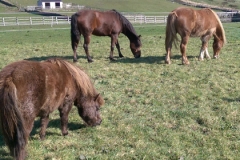Putting a glint in their eyes
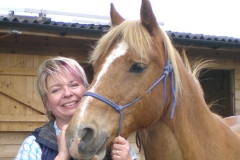 Horse Assisted Development can help people to develop key life skills by working with horses. Heidi Dawson describes how Glint, her Bolster Moor-based organisation, puts the theory into practice and enables people to transform their lives.
Horse Assisted Development can help people to develop key life skills by working with horses. Heidi Dawson describes how Glint, her Bolster Moor-based organisation, puts the theory into practice and enables people to transform their lives.
Sir Winston Churchill famously said “there’s something about the outside of a horse that’s good for the inside of a man”. I couldn’t agree more; simply by being with horses, people can gain a lot. By understanding how to put horses’ needs and welfare first and by learning how to care for horses, people can gain help to deal with challenges in their own lives … And having moved my three 4-legged friends to Pinfold Lane in Bolster Moor in April 2014, that more or less sums up exactly what I do.
From left to right: Gertie, Billy, and Zahra
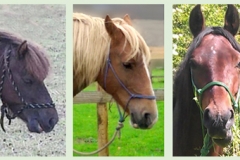 My 3 horses are: flirty Gertie, my mini-Shetland pony; brave Billy, my own riding pony; and curious Zahra, who didn’t have the best start in life. Together, we make up Glint — a not-for-profit organisation that uses Horse Assisted Development techniques as an effective alternative to traditional coaching, therapy and learning.
My 3 horses are: flirty Gertie, my mini-Shetland pony; brave Billy, my own riding pony; and curious Zahra, who didn’t have the best start in life. Together, we make up Glint — a not-for-profit organisation that uses Horse Assisted Development techniques as an effective alternative to traditional coaching, therapy and learning.
And no, we’re definitely not a riding school!
On the surface of things, you’d be hard-pressed to tell the difference between someone simply stabling their horses and the work I do. But the truth is that the one-on-one support I offer, simply through working and being with horses, is possibly one of the most effective ways of reaching people who struggle to respond to other more conventional methods of developing their confidence, skills or concentration. And as anyone who has ever laboured over mucking out and grooming will know, any help is welcome, however it comes!
Horses are good teachers — they give immediate and honest feedback. By observing a horse’s behaviour and then responding correctly, a student develops a trusting relationship with the horse. This relationship is the foundation of the student’s work with Glint’s horses.
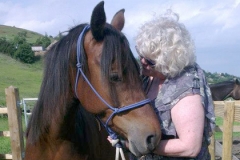 I mainly work with young and vulnerable people, helping them to develop a range of skills which are likely to boost their employability and chances in life generally. Our experience shows that interacting with horses can and does create real and lasting learning on so many different levels.
I mainly work with young and vulnerable people, helping them to develop a range of skills which are likely to boost their employability and chances in life generally. Our experience shows that interacting with horses can and does create real and lasting learning on so many different levels.
I’ve worked with some lovely young people who have found themselves going through very difficult times, but being around and working with the horses has given them a sense of purpose and responsibility, helping them to build their confidence and self-worth.
Sometimes family problems and other emotional issues can cause young people to disengage from school and learning — which is where we come in. Often it’s simply a question of conventional schooling not being right for a particular individual. But some students do respond incredibly well to the natural, outdoor learning environment and working with the horses as part of their alternative curriculum studies. As far as the students are concerned, they’re learning about horse care; but in reality, we’re talking about planning and managing activities, communication, influencing, negotiating, researching and delivering presentations — all invaluable life skills that will better place them to have successful lives and careers when they finish school. And all from something as simple as helping me to feed, groom, exercise and care for my horses.
Grooming strengthens the trusting relationship between student and horse. In addition, the process of building this relationship offers students insight and understanding about themselves and how they relate to other people.
The following case studies demonstrate the deep and lasting changes that can be made by working with Horse Assisted Development techniques:
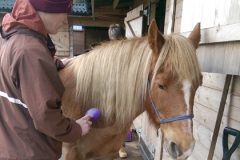 Student A was diagnosed as being on the Autism Spectrum and her behaviour in school was disruptive and attention seeking. She had high levels of dependency, poor balance and motor-skills, and she struggled to engage in learning. As a result of our support she has transformed her life: her balance and motor skills have improved, and her confidence and independence have increased to the extent that she has gained a college place to study NVQ Level 2 in Animal Care. Her learning mentor commented that she ‘can’t believe the difference’.
Student A was diagnosed as being on the Autism Spectrum and her behaviour in school was disruptive and attention seeking. She had high levels of dependency, poor balance and motor-skills, and she struggled to engage in learning. As a result of our support she has transformed her life: her balance and motor skills have improved, and her confidence and independence have increased to the extent that she has gained a college place to study NVQ Level 2 in Animal Care. Her learning mentor commented that she ‘can’t believe the difference’.
Student B was an intelligent young teenager but was being so badly bullied at school that she had virtually lost her voice and ability to communicate. She had begun to self-harm and threatened suicide. We worked with her to re-build her confidence and self-esteem, giving her the time and space to practice communicating assertively. After 6 weeks of just one 2-hour session per week, she was made captain of her school netball team and was leading and commanding the respect of the same students who had been bullying her.
Working with Glint’s horses can help young, vulnerable and disadvantaged people to deal with and overcome, for example, bullying, abuse, learning disabilities, autism, and eating disorders. Consequently, they can rediscover their purpose and direction in life.
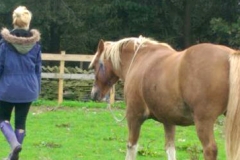 Student C had issues with anger management but refused to discuss this with her learning mentor, teachers or parent. As she built a trusting, non-judgemental relationship with the horse and her facilitator, she began to share information about the root cause of her anger; in addition, she not only developed strategies for managing her emotions but also identified and executed the actions she needed to take to address the underlying problems. She now feels that she has more input into decisions about her future and has plans in place to meet her father for the first time — so that she can judge for herself whether she would like him to be part of her life. As a result of being allowed to make more decisions about her life, she has stopped self-harming.
Student C had issues with anger management but refused to discuss this with her learning mentor, teachers or parent. As she built a trusting, non-judgemental relationship with the horse and her facilitator, she began to share information about the root cause of her anger; in addition, she not only developed strategies for managing her emotions but also identified and executed the actions she needed to take to address the underlying problems. She now feels that she has more input into decisions about her future and has plans in place to meet her father for the first time — so that she can judge for herself whether she would like him to be part of her life. As a result of being allowed to make more decisions about her life, she has stopped self-harming.
Horses are very suitable for the type of work we do for 3 reasons. First, they are emotionally intelligent, prey animals, which makes them very aware of their surroundings. Second, they live ‘in the moment’, so they respond to whatever ‘energy’ we humans are putting out there and they give us instant feedback on how we’re behaving and how we make them feel. Third, unlike other domesticated animals, such as dogs, horses are very genuine in their attitude towards us — they’re never trying to win our attention, bribing us with emotional blackmail, or judging our past, our appearance, or our potential to succeed in life.
An apparently simple activity can help with many different problems — a student leading a horse could be working on, for example, managing emotions, developing trust, assertiveness skills, communication, concentration, dealing with anxiety, or mobility.
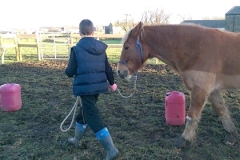 I’ve described what our students gain from working with the horses, but do the horses also benefit from the activities? Well, yes, they do: the horses benefit from having a job to do. Also, when they’re not working, we try to let them live as naturally as possible in a herd environment — as they would in the wild. Before they came to Glint, each of the horses had a life that didn’t necessarily give them the best experiences of being around people. By giving them the choice to get involved in our work, or to observe from a slight distance, Billy, Gertie and Zahra have developed into much more settled and courageous horses.
I’ve described what our students gain from working with the horses, but do the horses also benefit from the activities? Well, yes, they do: the horses benefit from having a job to do. Also, when they’re not working, we try to let them live as naturally as possible in a herd environment — as they would in the wild. Before they came to Glint, each of the horses had a life that didn’t necessarily give them the best experiences of being around people. By giving them the choice to get involved in our work, or to observe from a slight distance, Billy, Gertie and Zahra have developed into much more settled and courageous horses.
Despite the wind and rain, we love being at Bolster Moor — we hope you are proud to have us here! And, if we’re doing anything to make you anything less than happy, please let us know, so that we can try to do things differently. It goes without saying that you’re more than welcome to pay us a visit, but just remember to bring carrots and apples — my girls in particular are always grateful, but quite high-maintenance!

